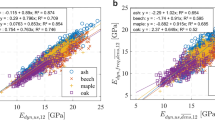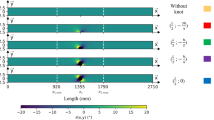Abstract
The potential of utilizing resonance frequencies corresponding to edgewise bending modes for predicting the bending strength of timber is investigated. The research includes measurements of axial and transversal resonance frequencies, laboratory assessment of density, static bending stiffness and bending strength of 105 boards of Norway spruce of dimensions 45 × 145 × 3,600 mm³. It is shown that E b,1 , (MOE based on the resonance frequency of the first bending mode) gives a higher coefficient of determination to the bending strength than what E a,1 (MOE based on the first axial resonance frequency) does. It is also shown that resonance frequencies corresponding to higher bending modes can be used in the definition of a new indicating property, the measure of inhomogeneity (MOI). This is a scalar value representing the lack of fit between the true, measured resonance frequencies and the expected (assuming homogeneity) resonance frequencies of a board. The results show that using the MOI as a third indicating property, in addition to E b,1 and density, increases the coefficient of determination with respect to bending strength from R 2 = 0.69 to R 2 = 0.75.








Similar content being viewed by others
Abbreviations
- σ m :
-
Bending strength
- E m :
-
Local MOE assessed by static bending
- E m,g :
-
Global MOE assessed by static bending
- ρ :
-
Board (average) density
- f a,n :
-
Res. freq. of axial mode n
- f b,n :
-
Res. freq. of bending mode n
- E a,n :
-
MOE calc. on basis of f a,n
- E b,n :
-
MOE calc. on basis of f b,n
- G b,n :
-
Shear modulus calc. on the basis of f b,1 to f b,n
- H a,n :
-
Measure of inhomogeneity, MOI, calc. on the basis of f a,1 to f a,n
- H b,n :
-
Measure of inhomogeneity, MOI, calc. on the basis of f b,1 to f b,n
References
Austrell PE, Dahlblom O, Lindemann J, Olsson A, Olsson KG, Persson K, Petersson H, Ristinmaa M, Sandberg G, Wernberg PA (2004) CALFEM A finite element toolbox, version 3.4. Studentlitteratur, Lund
Divos F, Kiss S (2010) Strength grading of structural lumber by portable lumber grading–effect of knots. The final conference of COST action E53, May 2010, Edinburgh
EN 408 (2003) Timber structures–Structural timber and glued laminated timber – Determination of some physical and mechanical properties. European Committee for Standardization, Brussels
EN 384 (2004) Structural timber–Determination of characteristic values of mechanical properties and density. European Committee for Standardization, Brussels
Johansson CJ (2003) Grading of Timber with Respect to Mechanical Properties. In: Thelandersson J, Larsen HJ (eds) Timber engineering. Wiley, Hoboken, pp 23–43
Larsson D (1997) Mechanical characterization of engineering materials by modal testing. Dissertation, Chalmers University of Technology
Larsson D, Ohlsson S, Perstorper M, Brundin J (1998) Mechanical properties of sawn timber from Norway spruce. Holz Roh Werkst 56:331–338
Steiger R, Arnold M (2009) Strength grading of Norway spruce structural timber: revisiting property relationships used in EN 338 classification system. Wood Sci Technol 43:259–278
Author information
Authors and Affiliations
Corresponding author
Rights and permissions
About this article
Cite this article
Olsson, A., Oscarsson, J., Johansson, M. et al. Prediction of timber bending strength on basis of bending stiffness and material homogeneity assessed from dynamic excitation. Wood Sci Technol 46, 667–683 (2012). https://doi.org/10.1007/s00226-011-0427-x
Received:
Published:
Issue Date:
DOI: https://doi.org/10.1007/s00226-011-0427-x




